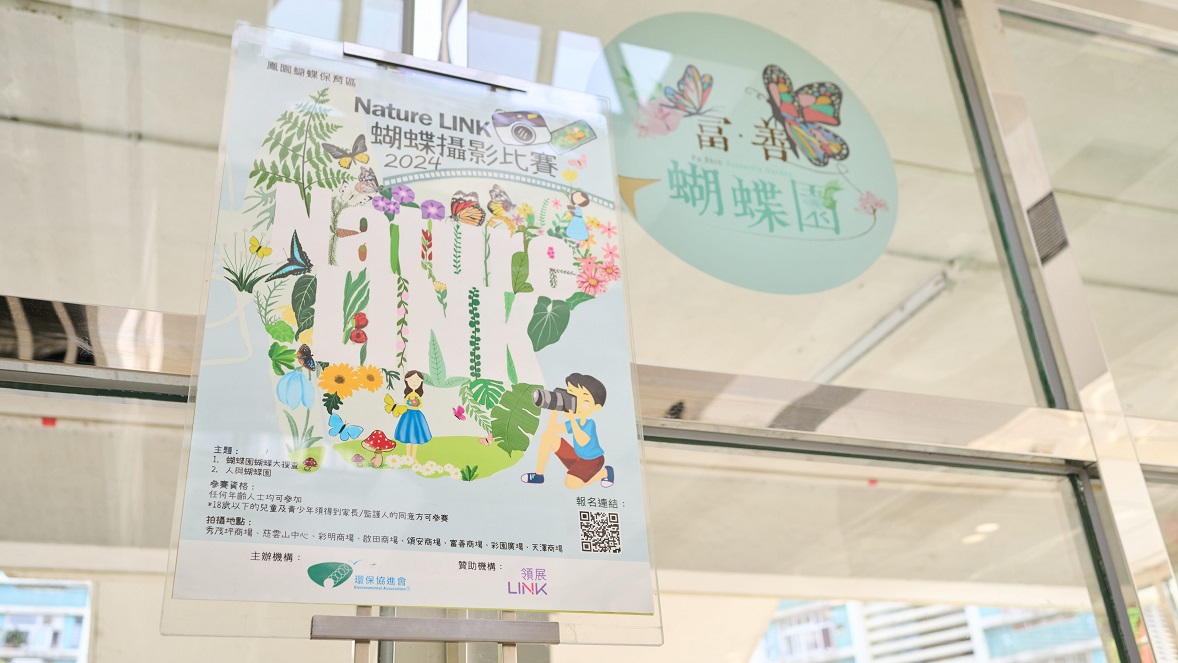
As spring transitions into summer, fluttering butterflies gracefully glide amongst beautiful flowers, captivating onlookers with the mesmerising hue of their wings. How can we “freeze” this fleeting moment of ethereal beauty?
For the Nature LINK Butterfly Photo Competition 2024, we invited Dave Choi, a professional photographer, to share some tips for capturing the elegance of butterflies. This competition is organised by the Environmental Association’s Fung Yuen Butterfly Reserve as part of its Nature LINK programme, a project sponsored by Link Together Initiatives.

Dave, who frequently scouts for “butterfly shots” at Link’s eight butterfly gardens, has a keen understanding of butterflies’ habits: “Butterflies prefer cooler weather, around 22 degrees Celsius. That’s why they’re most active between 9am to 11am and 2pm to 4pm, providing optimal opportunities for spotting and photographing them.” However, he recommends avoiding midday excursions: “This is when the sun is at its strongest and butterflies seek refuge from the midday heat. The harsh lighting also makes it challenging to capture a beautiful shot.”


People may wonder: given their small and delicate bodies, how does one capture their serene beauty of butterflies as they flit amidst flowers? Dave suggests observing their preferred flora and exercising patience: “Photographing butterflies is similar to wildlife photography. You set up your camera, concentrate on a specific location and wait for butterflies to appear.”
A butterfly makes a fluttering appearance during the interview. Dave moves slowly up to the branch where the butterfly has settled and begins capturing the moment, the clicking sounds of his camera shutter filling the air. He further cautions, “When you see a butterfly, resist your excitement and the urge to rush towards it, as your sudden movements may startle it away. We need to approach the butterfly gently and slowly.”
The photo competition features two themes, “Butterfly Garden Search” and “People and Butterfly Gardens”. When asked about the suitable composition techniques for the two themes, Dave remarks: “Butterfly Garden Search focuses primarily on the butterfly. Besides keen observation of the ecology of the community butterfly garden and patience while waiting for butterfly appearances, maintaining a clean and uncluttered background is equally important. Avoiding excessive shadows is also advisable, as butterflies frequently seek respite under bushes.”
As for “People and Butterfly Gardens”, Dave emphasises the connection between people and the butterfly gardens’ ecology. The photos should ideally embody the “human element” he says. “The butterfly gardens are situated in residential shopping centres. They provide opportunities for residents to gather, engage in communal activities and interact. The photos should showcase the dynamic interactions between residents and the butterfly garden. Examples include residents admiring the butterflies, elderly citizens coming here to cool off or parents and children watching butterflies together.”


The adage “a craftsman is only as good as his tools” rings true when photographing butterflies. Apart from seizing the right moment and considering the subject matter of photographs, selecting the appropriate equipment is equally essential for producing satisfactory results. Dave recommends using a telephoto lens (RF70-200mm) for capturing butterflies from a comfortable distance. Alternatively, a macro lens with a focal length of 100mm or more can yield a shallower depth of field, allowing photographers to isolate the subject and capture exquisitely detailed, sharp images of butterflies.


“In addition, given the small size of butterflies and their movements during photography, we need to use a smaller aperture, typically between f/5.6 to f/8, and increase the ISO for enhanced clarity of details. Similarly, a faster shutter speed makes it easier to capture the butterflies in motion or at rest,” Dave elaborates.


For people who are less versed in photography, Dave recommends broadening the scope of photography beyond butterflies when exploring the butterfly gardens. “The butterfly gardens are habitats bustling with life. While waiting for butterflies, we could hone our photography skills by capturing the surrounding flora and fauna, such as flowers, caterpillars and bees.” He encourages frequent visits to the butterfly gardens to practice photography, emphasising, “It is only through consistent shooting that you can pick the most captivating scenes and achieve the desired visual effects.”